Sharp MZ-80B
This page provides some introductory technical specifications about the MZ80B machine, and also showcases the MZ80B emulator produced by me.
Technical Specifications
Dimensions:
450mm x 520mm x 270mm
Approx. Weight:
16Kg
Processor:
4MHz Zilog Z80A Clone (Sharp LH-0080A)
RAM:
32K Standard DRAM,
Optional 32K Expansion Available.
2K Text Video RAM
ROM:
2K Character Generator
2K IPL (Initial Program Loader)
Operating System:
(None built in):
Initial Program Loader was used to load operating systems from Disk/Tape. These included Sharp BASIC, Disc BASIC (FDOS), CP/M 2.2
Keyboard:
92-Key Professional Touch
Display:
Built-In 9″ Green CRT (60Hz VSync, 15.75 KHz HSync)
Text:
40×25 and 80×25 software-switchable
Graphics:
(Optional) Hi-Res (320×200 pixels) – Each board contains 8K Video RAM:
Capacity for 2 Graphics Boards giving 2 independent mono 320×200 planes.
Audio:
8cm 32-Ohm 1-Channel Speaker. Max 400mW @ 440Hz
Storage:
Integral Cassette Tape. Software controlled transport system. 1800 bits/sec using Sharp PWM.
(Optional) Dual 5.25″ Floppy Drive
Architectural Components:
Zilog Z-80A CPU, Zilog Z-80A PIO Controller, Intel 8253-Compatible Precision Timer, Intel 8255-Compatible Peripheral Interface
Accessories
The MZ-80B was originally designed as a modular system. Some of the planned expansion modules were subsequently manufactured and sold, others, sadly, were not.
MZ080RM – 32K Expansion RAM Unit
This module inserts in “piggy-back” fashion over the standard 32K of RAM providing a total of 64K RAM
MZ-80GM – Hi-Res Graphics Card
This card clips beneath the CRT housing and connects to the motherboard using 2 ribbon-style cables with IDC Connectors.
MZ-80GMK – 2nd Hi-Res Graphics Card
This card is inserted into the MZ-80EU Expansion Unit, and coupled to the MZ-80GM 1st Graphics card using a ribbon-style cable.
MZ-80EU – Expansion Unit
This module holds up to 6 expansion cards, and is inserted in the cavity at the rear of the machine. It is connected to the PSU and Motherboard of the main machine. A MUST in order to add expansion cards.
MZ-80IO2 – Universal I/O Card
This card claims to offer a bi-directional interface to the computer. It was intended primarily for use as an RS-232 interface. Inserts into the MZ-80EU Expansion Unit.
MZ-8PB5I – Printer Interface Card
This card inserts into the MZ-80EU Expansion Unit and provides an interface for a centronics-style printer. Various printers were available (80-Col and 132-Col), and were based around EPSON Engines. Additional ROM sets were available to adapt existing Epson printers to print the Sharp character set.
MZ-80FI – Floppy Disk I/O Card
This card inserts into the MZ-80EU Expansion Unit, and allows connection of the MZ-80FD/FB/FBK Floppy Drive Units. Based around a Ferranti MB-8866 FDC I/C.
MZ-80FB(K) – Dual 5.25″ Floppy Drive (and MZ-80FD, the later model)
This external dual-floppy drive unit was suitable for connection to the MZ-80FI interface, and provided 2 drives each with 286K of storage capacity. Geometry of the disks was: 70 tracks (35 double-sided), 16 sectors, 256-Bytes per Sector.
Other expansions
Other devices planned included a Hard Disk interface, Punched Card Reader, Color Display, IEEE-Compatible interface. Unfortunately, details of these are scarce, and I have not been able to find out whether they were ever produced (either in prototype or commercially).
Tips for the Enthusiast
Tips & Tricks that may be of use or interest to other Sharp Collectors and Enthusiasts world-wide:
Tip #1 – Where there’s smoke, there’s fire?
Well, not exactly! I experienced a Power Supply failure with both the Computer and Floppy Drive. When connected to the mains, they produced lots of smoke.
This was caused by faulty smoothing capacitors across the supply connector. These capacitors are not required with today’s high-quality domestic power distribution, and can be safely removed, eliminating the smoke problem.
I have performed this mod myself, and it works OK for me, however I accept no liability for damage caused by performing this. Remember: Always disconnect the power supply before opening a piece of equipment, and if you are not sure what you are doing, always consult the aid of a qualified electrical engineer.
Emulator
After several incarnations (MS-DOS, Linux X11), finally the Windows version was completed. This is the most complete of any of the versions of my MZ80B Emulator (and in fact the only one I still have source code for!).
The emulator features a limited set of options, allowing for automatic emulated speed adjustment, and the ability to enable/disable the graphics memory expansion, RAM expansion and to insert/eject virtual floppy images.
The virtual floppy format is that used by the amstrad emulator utility CPDREAD (.DSK format) as this is the most compatible for the two primary formats used by the Sharp machine; a CP/M format, and an FDOS format. The emulator also includes a ubiquitous CPU debug display:
Emulation enables the use of the genuine IPL bootstrap ROM to boot the machine:
This ultimately permits both of the primary Operating Systems which were available to be executed (Sharp’s own FDOS which was a disk-based BASIC, and Digital Research CP/M 2.2):
When running FDOS, this enables some of the old games which were available for the Sharp MZ80B to be loaded from Disk and played:
Download Binaries:
 MZ80B Emulator Binaries (934.1 KiB, 2,063 hits)
MZ80B Emulator Binaries (934.1 KiB, 2,063 hits)
Download Source:
 MZ80B Emulator Source (107.1 KiB, 1,080 hits)
MZ80B Emulator Source (107.1 KiB, 1,080 hits)
Download pack of Floppy Images:
 SharpDisks.rar (2.4 MiB, 2,080 hits)
SharpDisks.rar (2.4 MiB, 2,080 hits)
Download Borland Libraries (needed by discmgr.exe):
 Borland Libraries (381.4 KiB, 1,305 hits)
Borland Libraries (381.4 KiB, 1,305 hits)
 Twitter
Twitter


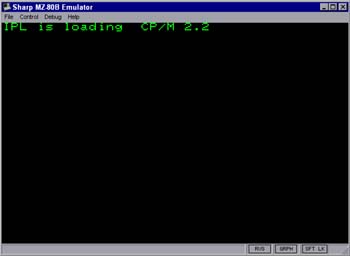
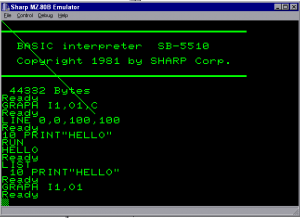
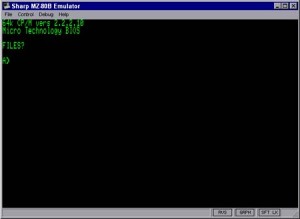
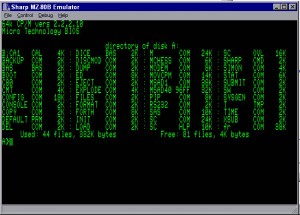
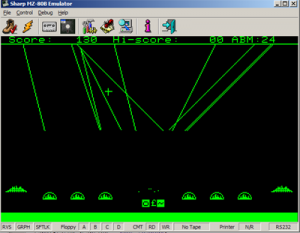
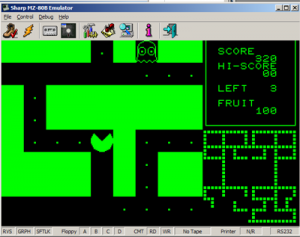
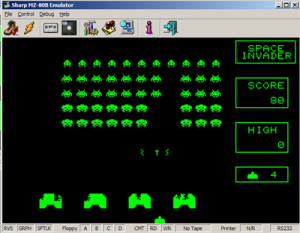
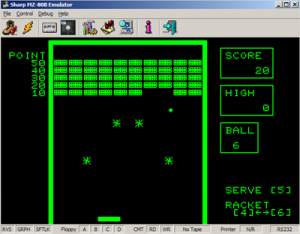
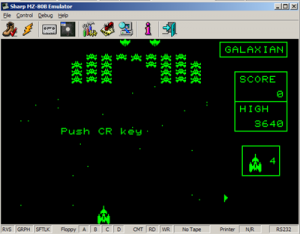
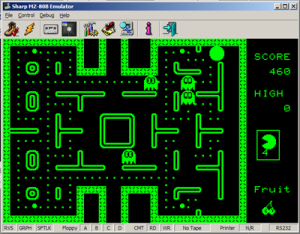
Dec 10, 2010 @ 19:44:33
Oooo, cheers for the pack of floppy images.
Ta.
Feb 04, 2012 @ 20:34:28
The discmgr.exe needs a dll named BORLNDMM.DLL – do you still have this one ?
Feb 04, 2012 @ 22:01:04
Hi Marten,
Yes indeed – Apologies for missing this (and thanks for spotting it!), I forgot to statically link the binaries when I originally published this. I’ve added a link to the MZ80B page, or you can access directly here: http://www.basoft.co.uk/wordpress/download/BorLibs.zip
The dlls can simply be placed in the same directory as the exe in order to work – no need to put them in system folder or anything like that.
Best of Luck!
Tony
Aug 28, 2012 @ 20:47:51
Got some of my old MZ-80B disks to life again, thanks to CPDREAD and your remarkable emulator – best of the three, I know.
Only, I (other users do not???) desperately miss something like a print-to-file function.
Is there
– any workaround (as Windows copy & paste is not implemented)
or
– a sequel to v2.97 for Windows 32-bit that is capable to print to whatother than NUL 🙂
or
– a preliminary version (perhaps an old MS-DOS version) that does
???
Thanks in advance, perhaps you know other users success in coding that?
Ulrich
BTW: using your mz80b297 within VMWare v5, guest OS WinXP pro cuts 4 pixel of the most bottom line – no way to cope because of fixed window size – therefore typing like into the mist…
Mar 03, 2013 @ 20:00:16
This is also true when running here under Windows 7 ..
>BTW: using your mz80b297 within VMWare v5, guest OS WinXP pro cuts 4 pixel of
>the most bottom line – no way to cope because of fixed window size – therefore
>typing like into the mist…
Mar 04, 2013 @ 11:44:35
Yes, I’m able to reproduce this 🙁
The main problem is I’m not able to rebuild the source easily any more, so I’m in the process of rewriting/reworking the emulator, but it’s a slow process due to limited available time.
It’s coming along, but not usable yet (mainly as I’m working on the disc support currently) I’ll post when I have more info though!
Aug 28, 2012 @ 21:54:21
Hi, glad you like the emulator – been a long while since I worked on this!!
What are you printing from – FDOS or CP/M, Text or Graphics, Which program – Wordstar? I still have my MZ80B in the attic, but more importantly the technical docs concerning the printer, so maybe it might be possible to do something with that (it only used a pair of I/O ports, so shouldn’t be so tough to include — IF I can build the source code these days lol)
Interested to hear about the VMWare issue though – would be interesting to see a screenshot of this problem if possible? You can email me directly via tony@the_domain_of_this_site – Can’t promise anything, but generally like problem-solving!! heh
All the best
Tony
Aug 30, 2012 @ 22:15:06
Hi Tony,
Thx for replying so soon – unfortunately I’m not ready for all answers today.
Repaired some faults on my MZ-80B recently (PCB capacitors blown, horizontally squeezed Screen…) and have to do a cassette player mending and the PCB repairs to printer (P5) and dual floppy the other days – so: no live MZ80-B screen shots for you to see what’s for yet.
Please await my e-mail for first answers, screen shots of VM etc. until Sunday evening.
Hey – I waited about 20 years for your emulator – a few weeks or months to have printout’s don’t bother me, since it would please the whole community of Friery-Fans 🙂
Thankfully
Ulrich
Sep 03, 2012 @ 09:30:37
Just a question to your screenshots about some games like Galaxian, Space Invaders or Arkanoid. Are these games included in the SharpDisks archive?
If yes, which disk and how I can load the games?
Sorry, for my my newbie questions.
Thanks.
Karl-Heinz
Sep 22, 2012 @ 17:06:36
Hi Karl-Heinz,
It should be included, yes – Try DISK15.DSK ?
Best Wishes
Tony
Sep 25, 2012 @ 14:28:19
I still have my mz80b (sitting on a shelf behind me as I type) and was amazed to see a virtually fully functional emulation of it available here. On the Linux/X11 front I can run the Windows binaries and DLLs using Wine on 64 bit FC17. Everything seems to work fine, though there are some interesting keyboard mappings. Z and Y are reversed, and most of the symbols seem to be dotted about the keyboard. It looks like this is mapped pretty much to the original layout, but for a European keyboard (which is fair enough). Is this correct, if so, is there any way can I tweak it to a more UK/US layout?
Cheers,
Jeff
Sep 25, 2012 @ 19:34:22
That’s great to hear that you find it interesting (and cool to learn that it runs under WINE too)! There’s definitely some strange stuff with the keyboard mapping – The Z/Y swap is to be expected as this would happen when you load a German edition of either CP/M or Sharp FDOS (where they would use a QWERTZ keyboard layout). This will all depend on the (OS) disk you’re running – some are German, some are not. The real issue, as a few people have pointed out, is the unusual keyboard mappings for the punctuation keys for example. These are mapped very similar to the original keyboard layout, and at the time I wasn’t sure how best to handle this – unfortunately they’re not configurable.
Following a comment from a German Sharp-fan I’ve picked up the project again and am looking to rewrite it, but my spare time is limited these days so it may take a while. I’d expect the keyboard to be re-mappable in that future version, if and when it’s done! I’d also like to take a look at getting working Printer and Tape support too (I have some ideas now how to do that).
So far the updated emulator is coming together – Part of the video core, all of the CPU core and some of the peripheral chips are complete. The video now runs more cycle-accurate (at 60Hz framerate) however the emulated board is not yet complete enough to even boot into the IPL ROM. I’ll post updated binaries (and eventually source) as it progresses into a meaningful state.
Tony
Mar 20, 2013 @ 00:06:19
Hi,
I was wondering if the games Send 1, Man-Hunt and Land Escape are available on any of these disks?
I owned a Sharp MZ-80A way back, and used to love those games. I’ve found versions of them for the Sharp MZ-700, but it’s not quite the same with all those extra colours…
I tried downloading this emulator but couldn’t really make any sense of it. I didn’t even manage to load anything… but if these games are in the collection I’ll try figuring things out.
Thanks in advance for any answers.
Mar 21, 2013 @ 07:47:38
Hi,
I haven’t come across those games yet, sadly. There’s a few others that I used to play that I haven’t got either either (Exploding Atoms; Wizards Castle; Las Vegas – A fruit machine game that loaded machine code from a file called LASV331A if memory serves, Hammurabi, Star Trek)
The Sharp User Club might be able to help but I imagine only with tapes/discs which are quite awkward to convert for emulator use (read almost impossible unless you can write software to do so!)
My emulator is for the “B” of course, so I guess there’s no guarantee that all titles were converted from the “A”
Thanks for the interest though – this was my first computer so I understand the nostalgia!
Tony
Mar 22, 2013 @ 08:23:05
Thanks for the reply. Yeah, these games were literally the first computer games I ever played (I would probably have played some arcade games earlier, but nothing that really stuck to the mind), so every few years I get the urge to experience them again. Heh, nostalgia would have been a lot easier if my first computer was a C64 instead!
Apr 03, 2016 @ 20:59:21
Hello,
very interesting site! I acquired such a machine yesterday, along with the dual floppy drives, and some floppies as well.
How did you create the img files of the floppies?
Jul 18, 2016 @ 12:07:44
Apologies for the massive delay Michael!
I use cpdread usually (a tool designed for reading Amstrad CPC disks), although have had some success reading the raw data using 22disk in the past. The problem isn’t usually reading the disks but writing them. You may find that you have more success when using a 360k 5.25″ drive instead of a 1.2MB drive, as these are closer to the original hardware and have a chunkier and more forgiving head.
The other issue may be running such low-level tools on modern Windows systems – unfortunately I haven’t tried this recently so can’t really advise how to get around that (other than using an old Windows 98 machine where possible).
All the best!
Tony
Oct 24, 2016 @ 12:35:15
Would be possible to reverse back the DSK images to real floppies?
Cheers.